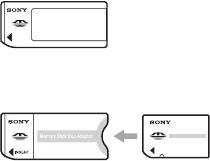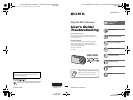
4
Notes on using your camera
Types of “Memory Stick” that can be
used
The IC recording medium used by this
camera is a “Memory Stick”. There are two
types of “Memory Stick”.
• “Memory Stick”
• “Memory Stick Duo”: Inserting a “Memory
Stick Duo” into a Memory Stick Duo Adaptor.
Memory Stick Duo Adaptor
• For details on “Memory Stick”, see page 88.
Notes on the “InfoLITHIUM” battery
pack
• Charge the supplied NP-FR1 battery pack
before using the camera for the first time.
(
t step 1 in“Read This First”)
• The battery pack can be charged even if it is not
completely discharged. Also, even if battery
pack is not fully charged, you can use the
partially charged capacity of the battery pack as
is.
• If you do not intend to use the battery pack for a
long time, use up the existing charge and
remove it from your camera, then store it in a
cool, dry place. This is to maintain the battery
pack's functions (page 90).
• For details on the “InfoLITHIUM” battery pack,
see page 90.
Carl Zeiss lens
This camera is equipped with a Carl Zeiss lens
which is capable of reproducing sharp images
with excellent contrast.
The lens for this camera has been produced under
a quality assurance system certified by Carl Zeiss
in accordance with the quality standards of Carl
Zeiss in Germany.
Notes on the AC Adaptor
• Do not short the DC plug of the AC Adaptor
with a metallic object, as this may cause
malfunction.
• Clean the DC plug of the AC Adaptor with a dry
cotton swab, etc. Do not use the plug if it is
dirty. Use of a dirty plug may not properly
charge the battery pack.
Notes on recording/playback
• Before you record one-time events, make a trial
recording to make sure that the camera is
working correctly.
• Be careful not to get the camera wet. Water
entering the inside of the camera may cause
malfunctions which in some cases may not be
repairable.
• Do not aim the camera at the sun or other bright
light. This may cause irrecoverable damage to
your eyes. Or it may cause the malfunction of
your camera.
• Do not use the camera near a location that
generates strong radio waves or emits radiation.
The camera may not be able to record or play
back properly.
• Using the camera in sandy or dusty locations
may cause malfunctions.
• If moisture condensation occurs, remove it
before using the camera (page 92).
• Do not shake or strike the camera. In addition to
malfunctions and an inability to record images,
this may render the recording medium unusable,
or cause image data breakdown, damage or loss.
• Clean the flash surface before use. The heat of
flash emission may cause dirt on the flash
surface to become discolored or to stick to the
flash surface, resulting in insufficient light
emission.
• To avoid the potential risk of data loss, always
copy (back up) data to other medium.
• The contents of the recording cannot be
compensated for if recording or playback is not
possible due to a malfunction of your camera or
recording media, etc.


















